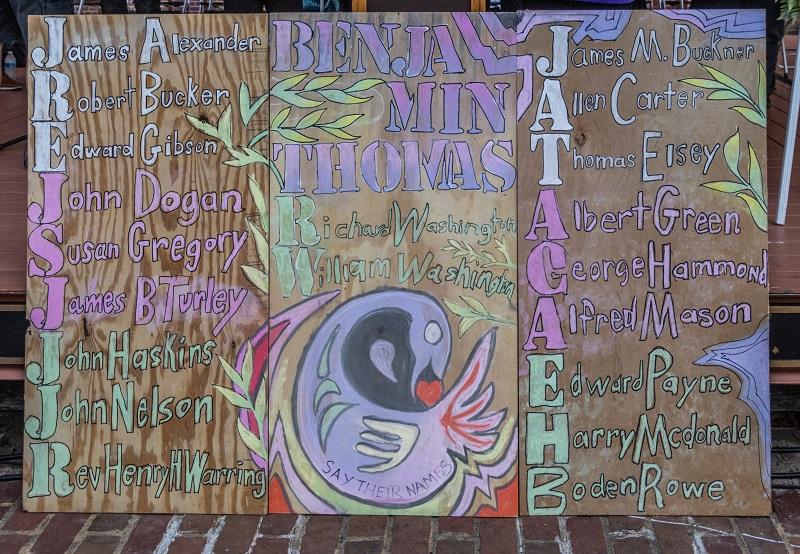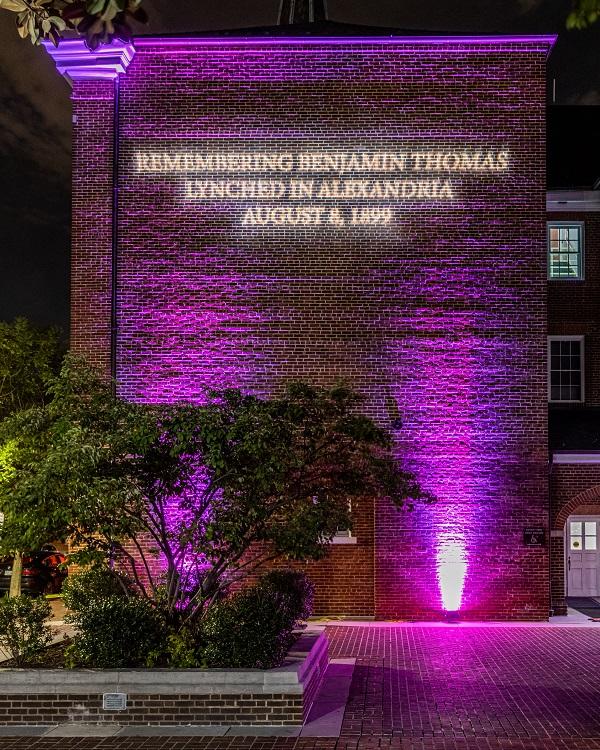
In Memoriam 2022: Benjamin Thomas August 8, 1899
In Memoriam: Benjamin Thomas August 8, 1899

On August 8, 1899, a lynch mob hunted down, tortured, and killed 16-year-old Benjamin Thomas, an African American boy and native Alexandrian. Thomas was arrested on Monday, August 7, 1899, for allegedly assaulting a white girl, but this was never proven. That night, Black community leaders warned police and the mayor that another lynching might occur, similar to the lynching of Joseph McCoy two years earlier on April 23, 1897. When the authorities refused their entreaties, the African American Alexandrians tried to protect Thomas themselves, standing guard near where he was being held. The police arrested them, and the next morning, they were, tried, fined and sent to the chain gang.
The City of Alexandria invites the community to remember the 1899 lynching of Benjamin Thomas and the heroes who tried to defend him at a ceremony at Market Square.
The 2022 memorial includes this In Memoriam page. For more information, also view the 2021 and 2020 In Memoriam pages and read the ACRP Newsletter.
Memorial Events
Monday, August 8, 6 p.m.
Market Square, 301 King Street
During this remembrance program, the community recognized and offered an opportunity to reflect upon the lynching of an innocent Black youth and the subsequent terrorizing of Alexandria’s African American community. We paid special tribute to the Black heroes who were willing to sacrifice their lives and livelihoods to protect a boy from a threatened lynching.
In addition to the Remembrance Ceremony, all were invited to:
- Visit Fairfax and King Streets where the Thomas lynching took place. A remembrance marker has been placed there by the Alexandria Community Remembrance Projects.
- Beginning Friday, August 5 through Monday, August 8, City Hall, the George Washington National Masonic Memorial and the lamp post at the corner of Fairfax and King Streets were illuminated in purple (the color of mourning) at night. This will be done in memory and respect for Benjamin Thomas and the men who stood up for justice and tried to protect him.
- Experience a temporary art piece by Nicole Wandera on Monday, August 8 on Market Square. The work of art is in recognition of the heroes who tried to protect Benjamin Thomas
Black Defiance
The story of the night Black Alexandrians protected Benjamin Thomas
On Monday, August 7,1899, the city’s African American community rose up to protect one of their own, Benjamin Thomas, 16, who had been arrested allegedly for attempting to assault a white girl. They were heeding the advice of the Black firebrand Richmond Planet editor John Mitchell, who wrote in May 1897 that “Colored men should see to it that their people are defended. With proper organization at Alexandria, the life of Joseph McCoy could have been saved, and the honor of the City of Alexandria upheld.” Six hours after police officers ripped Thomas from his mother’s arms, at least 15 African Americans were arrested for trying to protect him from a lynch mob.
Learn more in this article. Reprinted from the ACRP Newsletter (July 2022).
Benjamin Thomas Was Innocent
Reverend R. E. Hart of Washington, D.C. investigated the lynching and spoke with the Cleveland Gazette, which reported: “It is now generally admitted that he was not guilty. The mother of the girl told him [Hart]… the young man was not guilty and that she had known him from a youth to be a good boy.”
Learn more in this article. A shortened version of this story ran in the Alexandria Times, Out of the Attic column (July 28, 2022). The spelling of Freeman Murray’s name is corrected in this version.
Benjamin Thomas' Defenders
The following profiles were written after significant investigation and reflect the most accurate historical research to date. In 1899, there were multiple people with the same names living in Alexandria, and official records regarding Black life are conspicuous for their lack of detail and accuracy. We welcome any additional information about the tragic events of August 7 & 8, 1899.
Mr. James Alexander
Mr. James Alexander was a 32-year-old Black Alexandrian, the son of Willis and Mary. He was a black laborer who lived on Royal Street in The Berg (named after Petersburg). His home, just one block from Hard Corner at the intersection of Fairfax and Princess Streets, where the majority of the arrests were made on August 7, 1899. Alexander was charged with disorderly conduct and attempting to incite a riot and he was fined $10 or $357 today.
Mr. James Buckner
Mr. James Buckner, 53, was very active in several African American fraternal organizations and a leader among Alexandria’s Colored Republicans who often worked with James Turley, Magnus Robinson, Albert Green, William Washington, Shadrack Jackson, John Nelson and W.A. Carter. Buckner has been deemed a hero because as chair of the Committee on Entertainment at the Harmony Lodge of Colored Odd Fellows, he organized a cake walk (an event similar to musical chairs, but with slices of cake) to raise money for the Thomas family. During this event, a secret meeting was held to figure out how to disinter Benjamin Thomas from the pauper’s grave the City had laid him in and rebury him in a “more expensive coffin in a more fashionable cemetery and to have a Sunday funeral at a large scale.”(August 24, Alexandria Gazette, Aug. 24, 1899) Buckner lived at 306 N. Patrick Street with his family. In 1895, he was elected deputy grand master of Virginia’s G.U.O.F. Harmony Lodge. Buckner was also a member of the Good Samaritans and Alfred Street Baptist Church where he often led the choir. He was literate and was occasionally published in the Gazette where he worked the steam presses for more than 20 years.
Sgt. Robert H. Buckner
Sgt. Robert H. Buckner was the 49-year-old son of William, a shoemaker, and Mary, a domestic servant. The Buckners lived for many years at 205 Peyton Street and at the time of the 1880 census, Robert was working for the railroad. A family of Buckners were members at Roberts Memorial Chapel. It appears likely that Robert joined the US Army in 1882, went to Texas, becoming a Buffalo Soldier. Buckner rose to saddler sergeant, responsible for a company of men who kept the horse and leather equipment ready for use by the 10th Cavalry. Robert likely picked up some of these skills from his father’s shoe and boot repair business. His service finished in March 1887, and after returning to Alexandria, Robert married Mary Cox in 1888 - he was 32 years old at the time. Robert and Mary moved into a home in The Berg at 414 N. Pitt Street. During his lifetime, Buckner worked tirelessly to establish a national pension fund for the formerly enslaved, including organizing a national convention to petition the President of the United States. When Mr. Buckner died in January 1917, the Alexandria Gazette wrote of him, “Robert Buckner, a respected colored resident, died at the Alexandria Hospital last night.” His mother, Mary Buckner, a widow at the time of the lynching lived across the street from the Thomas family (711 N. Patrick). By the time the 1900 City Directory was published, she had moved to 415 N. Patrick - a house near to William Thomas who may have been related to Benjamin’s family.
Mr. Allen Carter
Mr. Allen Carter was just 19-years-old on Monday night August 7, 1899, when he was arrested for attempting to protect Benjamin Thomas. Mr. Carter was most likely living at 128 S. Royal Street in a rooming house. He was either the son of Henderson and Lettie Carter or John and Annie Carter (who lived in the Plains). In the 1920 Census he was living with Edward Carter, the son of John and Annie, and was listed as a Boarder. Edward Carter worked as a driver and then for the Railroad. When Edward died in 1930, he was buried at Douglass Memorial Cemetery.
Pvt. John Thomas Elzie
Pvt. John Thomas Elzie (Elsey, Elzy) was also about 19-years-old and lived in The Berg at the time he was arrested. Like his father Edward, an Alexandria County man who fought for the Union during the Civil War, John Thomas also served in the military. In 1898, after a lackluster showing from white citizens, Virginia Governor James Hodge Tyler called up colored men to fight in the Spanish-American War. Elzie was among those recruited in Alexandria, as was Benjamin’s older brother James Thomas; others who served and were implicated on August 7 included Edward Gibson and William Washington. Pvt. Elzie and Pvt. James Thomas were in Company C and served with the 10th Immunes. (The term Immunes was racist as well, based on the wrong belief that Black men would be less susceptible to tropical diseases that were wiping out the white troops in Cuba.) These soldiers were stationed in Jim Crow Georgia where they had to endure severe racism. They quickly realized the US Government was not going to look out for Black soldiers and they would have to protect each other. After that experience it isn’t surprising that Elzie stood for Benjamin Thomas. Elzie was charged with disorderly conduct and attempting to incite a riot. He was fined $10, or $357 today. A month later (Sept. 16, 1899) he was arrested for accidentally killing William Pinkney, also African American. However, the jury agreed the shooting was accidental and fined him $5 for carrying a pistol plus time served. Two years later Elzie married Mary J.E. Lewis.
Pvt. Edward Gibson
Pvt. Edward Gibson was a war veteran twice over serving with the 24th Colored Infantry in the Civil War and again with the 24th during the Spanish-American War. On July 12, 1899, Edward Gibson was honorably discharged from the latter conflict. Less than a month later he was arrested for defending Benjamin Thomas, charged with disorderly conduct and for carrying a concealed weapon. He was fined $20 the equivalent of $714 today. Gibson lived near the railroad at 221 Commerce Street and worked as a driver. When he died in 1939, Gibson was honored with a burial at the National Cemetery in Baltimore, MD.
Capt. Albert Green
Capt. Albert Green was born in 1862 to George and Cora, he grew up in The Berg. As a teenager Albert Green worked as a laborer. It is likely he joined the 6th Virginia Volunteers in the 1880s. The all Black militia heavily recruited laborers and due to the timing of his enlistment, Green was probably among those sent by Virginia Gov. Fitzhugh Lee to Newport News in January 1887 to help put down a violent strike led by Longshoremen. The following December, Green was discharged from Ft. Myer after serving time for a military infringement. In 1892, he was instrumental in creating The Robinson’s Industrial Guards named after the editor of The Leader, Magnus Robinson (a prominent Black Republican in Alexandria who had worked with Frederick Douglass). The Guards marched in industrial parades, drilled at fairs and took part in Emancipation Day parades in Alexandria and Washington D.C. The men chose Green to be their Captain. Throughout the decades, Green played a leading role at many republican meetings. Often, he was listed in the newspapers as the Sergeant-at-Arms. Green also spent time on the executive committee, and in 1900, he was selected, along with James Turley and John Nelson to meet with then-President William McKinley to describe the “unsatisfactory state of affairs” for Black republicans in Alexandria and Virginia. But before that, in 1897, after the lynching of Joseph McCoy, when the African American community was forced indoors by roving bands of armed white men, a press account reported that a small African American military company armed with wooden rifles drilled on N. Pitt Street led by Capt. Green. He showed his willingness to stand up for the law and for his race again in February 1904, when police arrested Green for hiding George Hobday who was accused of assaulting a white woman. In 1907, Green and William Washington established The Pall Bearers Union to serve at funerals for Alexandria’s Black families. Capt. Albert Green was 36-years-old when he organized at least one hundred men to stand up for Thomas on August 7, 1899. He was the first arrested and was charged with disorderly conduct, attempting to incite a riot and was fined $20, or $714 today.
Mr. John Haskins
Mr. John Haskins was born in Alexandria in 1878 to George Charles David and Mary Jane Tenie, another of Alexandria’s established Black families. Haskins was short, he had a medium build, black eyes and hair. He and his wife Ella raised four children and several grandchildren in The Berg at their house at 515 N. Pitt Street. Haskins served in WWI (his rank unknown at this time). As a literate laborer, Haskins was able to work in a variety of Alexandria businesses over the decades, at the time of the 1930 Census, he worked at the Fertilizer Plant. Haskins died in 1939 and is buried at Douglass Cemetery. On the night he stood up for Benjamin Thomas, John Haskins was 21-years-old, he was charged with disorderly conduct and attempting to incite a riot. He was fined $10, or $357 today.
Mr. Alfred Mason
Mr. Alfred Mason, a young man at the time of the lynching, would eventually work at the Virginia Carolina Chemical Co. and serve his country in WWI (His rank unknown at this time). Mason was average height, a slender, dark eyed young man, the son of Peter Mason and grandson of Daniel and R. Mason. He was related to the Middletons, another established Black Alexandria family. At the time he was arrested for defending Benjamin Thomas, Mason was probably living on the 400 block of N. Fairfax Street in The Berg. He was charged with carrying a concealed weapon, disorderly conduct and trying to incite a riot and was fined $20, or $714 today. Alfred Mason died in 1922 and is buried in Douglass Cemetery.
Mr. Harry McDonald
Mr. Harry McDonald may have been a hired driver. When he was arrested on August 7, 1899, McDonald was charged with carrying a concealed weapon, disorderly conduct and trying to incite a riot. He was fined $20, or $714 today.
Mr. John Nelson
Mr. John Nelson, 44, the grandson of Alexandria’s John and Patsy Nelson and son of George and Virginia Fuller, was from an established Black family free before the Civil War. Nelson was very active in the Republican Party and on Election Day in 1896, he accused Ward Two election worker John McCuen of changing his vote. He applied for a warrant for McCuen’s arrest, but Chief of Police James Webster refused to issue it until the election was over arguing McCuen was a respectable citizen. Albert Green stood as a witness at the trial and corroborated Nelson’s claim, but McCuen was exonerated and Nelson forced to pay the costs of the trial (Alexandria Gazette, Nov. 5, 1896.) Over the decades, Nelson held leadership positions in the Republican Party, often working with James Buckner, Albert Green, William Goings, Thomas Morgan, James Payne, Moses Stevens, James Turley, Shadrack Jackson, A.A. Warfield and William Washington. He was a laborer and lived in The Berg at 315 Princess Street - next to the intersection with N. Fairfax Street known as Hard Corner. It was at this intersection on the edge of two African American neighborhoods: The Berg and Fishtown where police arrested most of the men who stood up for Benjamin Thomas on August 7, 1899. Although Nelson escaped arrest, an officer pointed to him while testifying in court the next day and said Nelson had been involved. He was brought before the court, but the charges were dismissed. In 1900, Nelson joined Turley and Green when they met with then President William McKinley about the state of affairs for Black republicans in Alexandria and Virginia.
Mr. Edward (Ned) Payne
Mr. Edward (Ned) Payne lived “at the back of 418 N. Royal” in The Berg. He was no stranger to a fight. In the early 1880s, Payne was arrested after being involved in a violent street fight between whites and Blacks. In March 1899, while serving on the chain gang, Payne led a strike. He was 40-years-old when he was arrested and charged with disorderly conduct and attempting to incite a riot. He was fined $10, or $357 today.
Mr. James B. Turley
Mr. James B. Turley, 49, was a widower who worked as a burner of bricks in the brick yards north of the city. He moved from Alexandria County to the city, his family were free before the war and were founding members of Roberts Memorial Chapel. He was related to Simon Turley and George Seaton, two famous Black Alexandrians, who were well respected by both the white and Black communities. Turley was the head of the Republican Party for his ward in August 1899, he had served in many party offices and on many delegations over the decades. He was also among those selected to meet with President William McKinley in 1900. Turley was on his way home from a late shift at the Brick Yard on Monday, August 7, 1899 when he heard the whites talk of lynching “some negro,” he set out to find out who was being threatened and organize a delegation to ensure the rule of law held and that Benjamin Thomas would not meet the same fate as Joseph McCoy had two years earlier.
Mr. Richard Washington
Mr. Richard Washington, 26, the son of James, a coal worker and Fannie, a seamstress was most likely the same man identified in newspapers as the Richard Washington who was arrested on August 7, 1899. James and Fannie would have been contemporaries of Elizabeth and George Thomas and may have been related to Benjamin’s mother Elizabeth (Washington) Thomas. They lived at 925 Oronoco, between Alfred and N. Patrick Street, three blocks from the Thomas family and around the corner from Turley. Richard could read and write and when he was old enough, he began working at the Iron Works on S. Royal Street (where Safeway stands today). In 1899, Richard was working as a Porter for the railroad and he was living at Robert Buckner’s old house at 205 Peyton Street. Robert Buckner also worked for the railroad as did Benjamin Thomas’ older brother James, who we believe was a Porter.
Mr. William Washington
Mr. William Washington, 33, was sitting in the courtroom Tuesday, August 8, 1899 for the trial of the Black men, many of whom were his friends. While on the witness stand, a police officer identified Washington and claimed he saw him with the others the night before. John Nelson was sitting beside Washington in the gallery. Both men were brought before the court, but the charges were dismissed. Washington was the only son born to Susie and James Washington (they adopted Ellis Day and Lottie White). He grew up in The Berg around the corner from Albert Green at 512 N. Royal St. Back in the 1870s The Berg was a hotbed of radical republicanism and William’s father was a party activist as well as a member of the colored Freemasons and the colored Odd Fellows. Once grown, William followed his father into local republican politics. He worked on- and-off as a bartender (his father worked at the Brewery) and it is very likely that he served in the Spanish-American War. Throughout the decades, William, Green, Turley and Nelson attended the same political meetings. In 1907, Washington and Green started the Pallbearers Union to help bereaved Black families.
Mr. John Wilson
Mr. John Wilson was born in 1879 to Emma and Jason Wilson in Greenville, S.C. In 1899, he was living in Alexandria and would have been 19 or 20 years old. A well-educated, clever Black man, he often found himself at odds with white police officers. On Thanksgiving Day, 1912 he stole a Turkey from W.P. Wolds & Son’s store at the corner of Queen and Henry. It was his third offense, all petty and nonviolent, yet he was sentenced to a full year in the state prison. As WWI broke out, Wilson, now around 33 years-old, was in the penitentiary where he was drafted. When his ship left New York on July 30, 1918, he was AWOL. A few weeks later, Wilson was the last passenger listed on the Lenape as it left Hoboken, N.J. John Wilson served in Company B of the 140th Machine Gun Battalion. On August 7, 1899, Wilson was charged with disorderly conduct and attempting to incite a riot. He was fined $10, or $357 today.
Mr. George Hammond
Mr. George Hammond (Hammons, Hamilton), 23, was with a band of Black Alexandrians who met at the railroad yards near Portner’s Brewery determined to try to stop the whites who were forcing their way into the prison. Hammond, born to Sarah and George, a gristmill worker at Mount Vernon, was raised there. He recently moved to the city and was working as a porter for the railroad. On August 7, 1899 his wife, Cora was at home caring for their infant daughter Mary as he and the men approached the lynch mob on St. Asaph Street. Upon sight, the whites aimed their guns and opened fire. George was shot in the back and dragged to safety. Two days later he showed up in the infirmary fighting for his life (The Washington Times, Aug. 11, 1899). George survived his bullet wound and after he recovered, he moved his wife and daughter to Jersey City, N.J. where he lived out the rest of his days working for the railroad.
Mr. John Dogan
Mr. John Dogan was a teen when the lynch mob mistook him for Benjamin Thomas. Alexandria police were familiar with young Dogan whose antics first brought him before the mayor’s court in 1895. On August 8, 1899, Dogan was behind bars for pickpocketing $19 from a man he was “helping” over a fence. His case came up on July 13, but instead of hearing it, the Judge continued it until October when the court would be in session. Members of the white mob pulled Dogan from his cell, put a rope around his neck and readied to kill him before learning he was not Thomas. Dogan was a victim of racial terror.
Mr. Boden Rowe
Mr. Boden Rowe (a.k.a Alexander Rowe) was also mistaken for Benjamin Thomas on the night he was lynched. He was in jail on charges for stealing a horse and wagon from an Alexandrian and selling it in Washington, D.C. for $25 to McGrath & Kennelly. Rowe fled to New York City where he was found by local authorities and arrested on July 7. Deputy Sergeant B.B. Smith brought him back to Alexandria on July 13, 1899. Rowe was being held until the court reconvened. The papers reported that Rowe was shot at by the mob as he ran from them. Once they realized he was not their target he was released. After that, news reports indicate that Rowe likely made an effort to protect Benjamin Thomas. He was given permission by police to follow the mob down St. Asaph Street, perhaps some thought Rowe may be able to wrestle Thomas from the mob and bring him back to the jail. However, Rowe returned to the jail with police officers later that night after witnessing the torture and killing of an innocent Black boy.
Mrs. Susan Gordon
Mrs. Susan Gordon (Gregory), 56, arrested for disorderly conduct after Benjamin Thomas was lynched was most likely Susan Gordon (newspapers called her Gregory), a widow and a mother. It was reported that Mrs. Gordon stood outside the Kloch home and engaged in a verbal altercation with the family. Elijah Gordon, her deceased husband, fought in the Civil War and worked for the railroads. Gordon was a washerwoman and she most likely lived at 218 N. Henry Street. Mayor George Simpson dismissed the charges against her the following day.
Rev. R.E. Hart
Rev. R.E. Hart, the leader of Israel Christian Methodist Church (Washington, D.C.) and representing the National Organized Brotherhood of Afro-Americans, showed great bravery by coming to Alexandria hours after Benjamin Thomas was lynched to investigate. He spoke with Julia Kloch, the mother of the child who accused the boy, who said Benjamin was not guilty, adding she had known him to be a good boy. When Mayor George Simpson tried to avoid Hart, he persisted, and in the end, Simpson told the minister that Benjamin’s guilt was “doubtful.” The Cleveland Gazette wrote of Rev. Hart, “He deserves great credit, and it shows pluck to have gone into such a community to investigate such an outrage, where an angry militia armed with Winchesters was looking for ‘a race riot,’ as the authorities claimed, in order to divert public attention from a crime that had again brought disgrace on Alexandria and its white citizens.”
A Poem for Benjamin Thomas
In Memory of Benjamin Thomas, 1883-1899
c) Zeina Azzam, Poet Laureate of the City of Alexandria, Virginia, August 2022
A sense of foreboding spread
through Alexandria’s streets
the night before the lynching.
The crescent moon, as it set
in the western sky, illumined
scores of Black men who gathered
to protect Benjamin Thomas
as he languished in his jail cell.
But the mayor and police halted
the community’s heroic efforts
like a raging fire can silence a town.
Alone and vulnerable,
Thomas would later emit a scream
from the depth of his being,
the primal cry to his mother
for succor in his final moments.
Let us honor this voice
and this bright life
beyond his gruesome death,
this once vibrant body full of promise
now tortured and maimed
and hanged until lifeless.
With his lynching a piece of us was killed, too:
We wear the same shroud.
How do we make sense of
Benjamin Thomas’s short life?
If we callously allow simple hemp fibers
to become a noose,
a poplar tree or a lamppost
to become a gallows,
what will we fashion
of our history books?
His life breath, usurped violently,
is like ours, fragile
and full of human spirit,
innocent and vital.
One with our mother breath.
May our grief over his cruel loss
impel us to action.
May his memory nourish our resolve.
The Program on Market Square
Musical Prelude, Shiloh Baptist Church Choir
Welcome, Reverend Professor Quardricos B. Driskell, Beulah Baptist Church
Narrative Read by Alexandria City High School Students
- The Arrest, Amel Mohali, Senior
- The Defense, Naeem Scott, Senior
- Court Appearance, Rodase Demissie, Senior
- The Lynching, Miracle Gross, Senior
- Hands Unknown, Yahney-Marie Sangare, Junior
Remarks, Hon. Sean Casey, Sheriff
“In Memory of Benjamin Thomas, 1883-1899”, Poet Laureate Zeina Azzam
Recognition of Benjamin Thomas & Recognition of the Heroes, Rev. Driskell
Call and Response, led by Rev. Driskell and Alexandria City High School Students: Jenaba Bah, Junior; Reema Gaal, Senior; Amel Mohali, Senior; Andrea Funes Quiñones, Senior; Torenzo Ricks, Junior; Amna Shamseldin, Senior; Chellseigh Waruzi, Senior














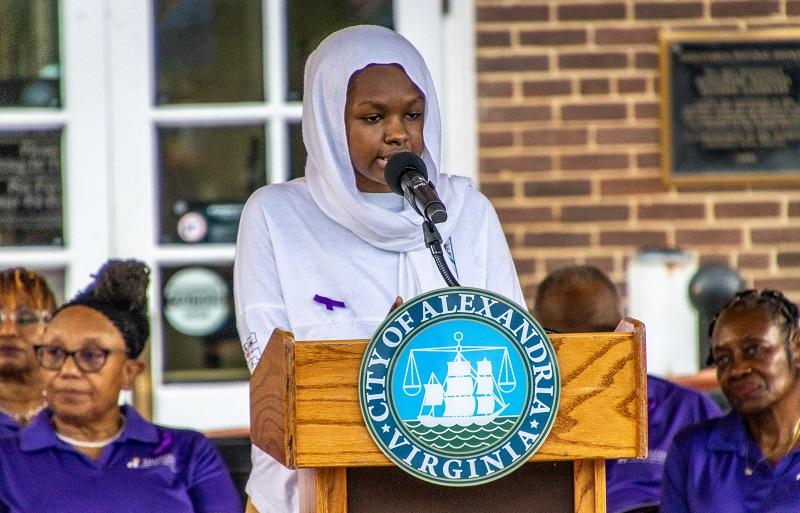
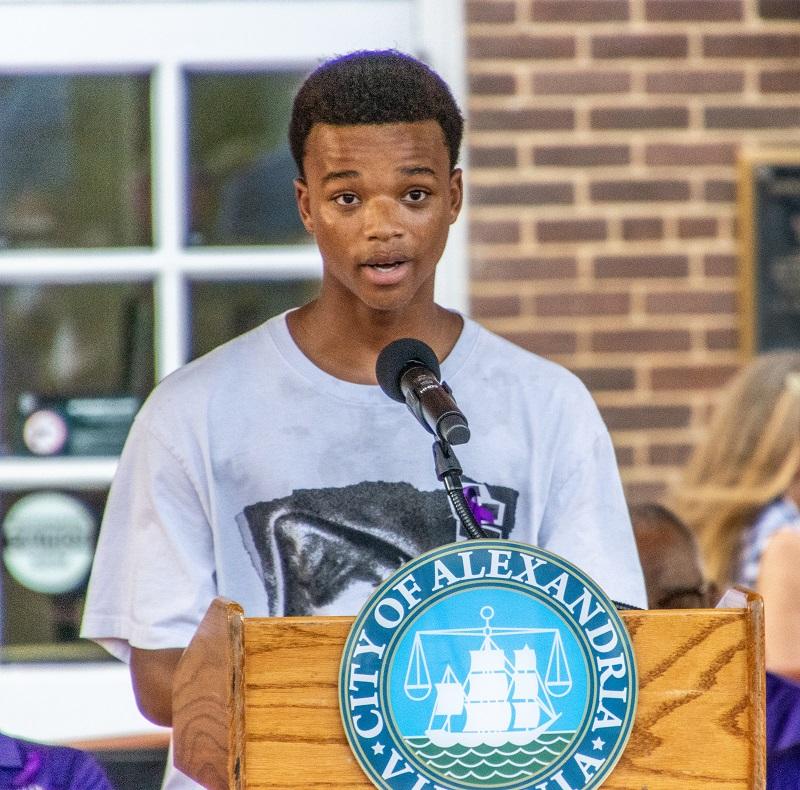



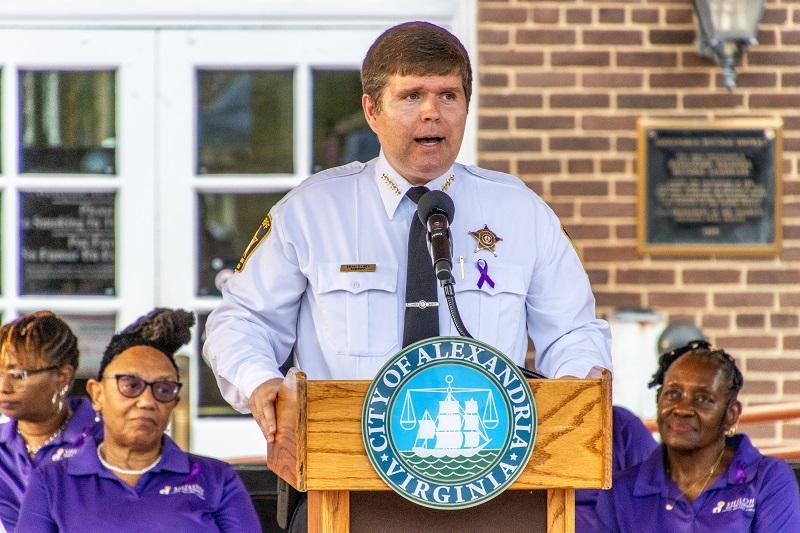
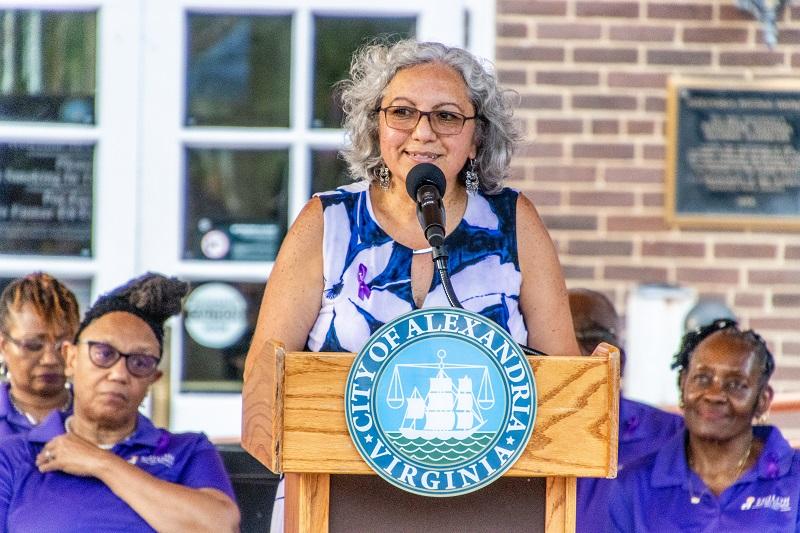

Wreath Laying
A procession from Market Square to the Lynching Site was followed by
- Wreath Laying by the Worshipful Grand Historian McArthur Myers, 31st Masonic District MWPHGLVA
- Reflection and Benediction Reverend Dr. Taft Quincey Heatley of Shiloh Baptist Church
- “This Little Light of Mine” by Shiloh Baptist Church Choir
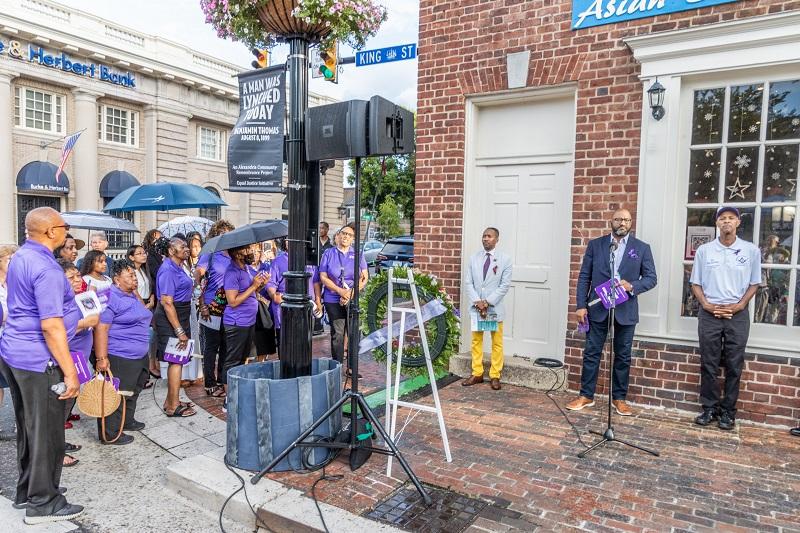




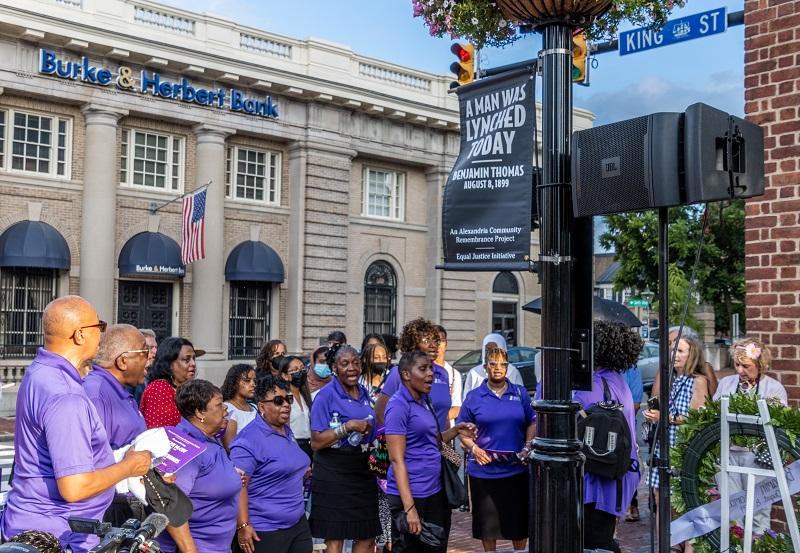
Chalk Art by Nicole Wandera
Ms. Wandera, an interdisciplinary artist, was born in Nairobi, Kenya and currently is based in Northern Virginia. Read more about the artist in the Program.
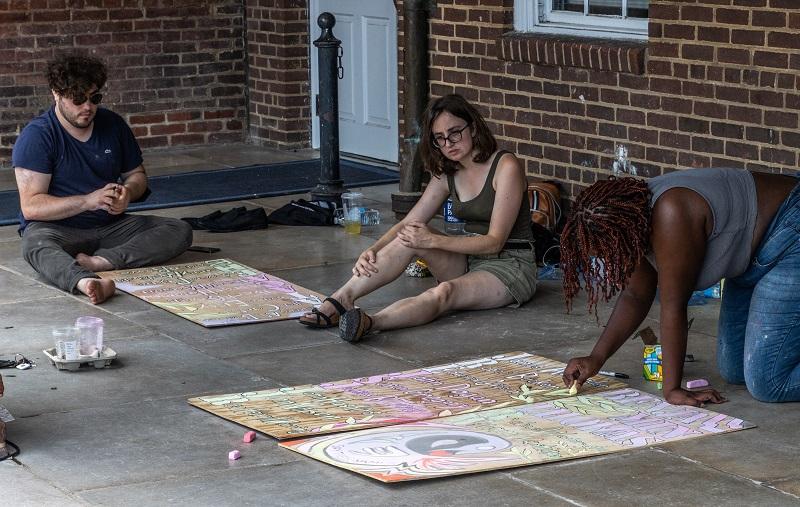

The Illumination of City Hall
City Hall, the George Washington National Masonic Memorial and the lamp post at the corner of Fairfax and King Streets were illuminated in purple (the color of mourning) at night. This was done in memory and respect for Benjamin Thomas and the men who stood up for justice and tried to protect him.

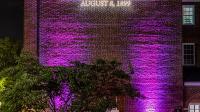
In the News
"Do You Hear the Blood?" City Remembers Lynching Victim Benjamin Thomas. By Jeanne Theismann, Alexandria Gazette, August 11-17, 2022.
Alexandria remembers Benjamin Thomas, 16-year-old Black boy lynched in 1899. By Max Marcilla, DC News Now, August 8, 2022.
Alexandria Community Remembrance Project (ACRP)
ACRP is a city-wide initiative dedicated to helping Alexandria understand its history of racial terror hate crimes. ACRP conducts research, education, programs, and events that remember Joseph McCoy and Benjamin Thomas and explores the long-term impacts upon Alexandria’s African American community. Working with the Equal Justice Initiative Remembrance Project, ACRP will receive a steel pillar that memorializes McCoy and Thomas and with it will create a permanent space for remembrance in Alexandria City. The work of ACRP is an effort to establish a welcoming community bound by equity and inclusion for all people.
Benjamin Thomas and Joseph McCoy are the only two documented Alexandria lynchings so far. McCoy was lynched on April 23, 1897. This year is the 125th anniversary of that event. It was commemorated on that date.
